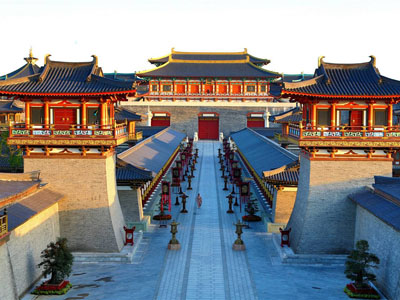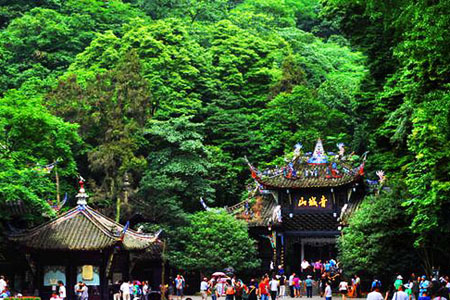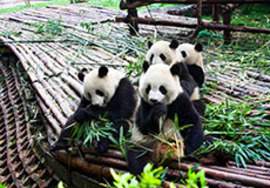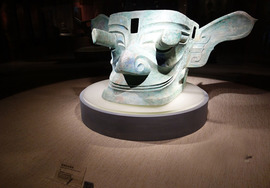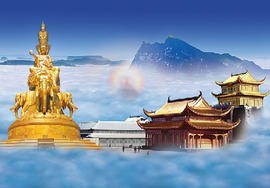Sky Burial
At the top of the ridge, on a platform of stones encircled by prayer flags, the tomden, o yogin-butcher, unwraps the body and slices it from head to toe, exposing the underlying flesh and bones. Drawn by the smoke from the juniper fire and the smell of fresh meat, huge vultures begin to gather on the surrounding rocks. His soul already transferred to celestial space, the dead man's body is used to benefit other living beings.
The majestic vultures, thought by Tibetans to be manifestations of flesh-eating dakinis, glide down from the high ridges and surrounding rocks and dance restlessly around the tomden and the unveiled corpse. "Shey, shey," (Eat, eat"), shouts the tomden. The birds descend, enveloping the dead man's body in a frenzy of dark shifting wings.
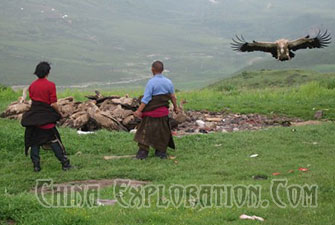
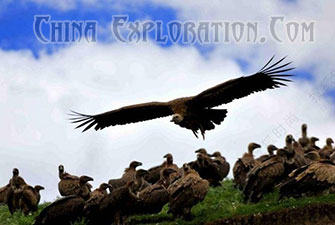
The dead man's body is used to benefit other living beings
Like a bodhisattva shaman, the tomden goes back in among the vultures and begins to dismember the skeleton, throwing arm and leg bones to the ravenous birds. Then, with a stone mallet, he pulverises the remaining bones. Reciting mantras, he takes the skull and crushes it with a large rock. He mixes the brain and powdered bones with tsampa flour and again invites the birds to feast.
Soon there is nothing left: only wisps of smoke from the juniper fire drifting across the barren stones. The birds fly heavily to the crest of the ridge to digest; then, slowly, they soar off into the heavens - black shapes fading against a pale, unending sky.
About The Reincarnation of the Living Buddha
The reincarnation of holy men, or "Living Buddha," is a unique form of succession in Tibetan Buddhism which has long been recognized and respected by the State. It is the main point distinguishing Tibetan Buddhism from other forms of Buddhism. What led to the introduction of the system.
The term Living Buddha emerged in the early Yuan Dynasty (1271-1368) when Emperor Kublai Khan honored Pagba, head of the Sagya Sect, by granting him the title "Buddha of the Western Paradise.'' Thereafter, eminent Tibetan monks we distinguished them in the practice of Buddhism were referred to as ''Living Buddhas.''
In 1252, Kublai Khan granted an audience to Pagba and Garma Pakshi, an eminent monk with the Garma Gagyu Sect. Garma Pakshi, however, sought the patronage of Monge Khan who proceeded to bestow him a gold-rimmed black hat and a golden seal of authority.
Prior to his death in 1283, Garma Paksli penned a will to ensure the established interests of his sect. The will advised his disciples to locate a boy to inherit the black hat, with the instruction based on the premise that Buddhist ideology is eternal, and a Buddha would be reincarnated to complete the missions he had initiated. Garma Pakshi's disciples acted in accordance with the will and located the reincarnated soul boy of their master.
The event marked the introduction of the Living Buddha reincarnation system for the Black-Hat Line of Tibetan Buddhism. During the Ming Dynasty (1368-1644), Emperor Yongle honored Black-Hat Living Buddha Garmaba as the ''Great Treasure Prince of Dharma,'' the first of the three "Princes of Dharma.'' The Living Buddha reincarnation system remains in operation today.
Various sects of Tibetan Buddhism reacted to the introduction of the Living Buddha reincarnation system by creating numerous similar systems. The most influential reincarnation systems have since been the Dalai and Bainqen Lama systems.
Related Tours
